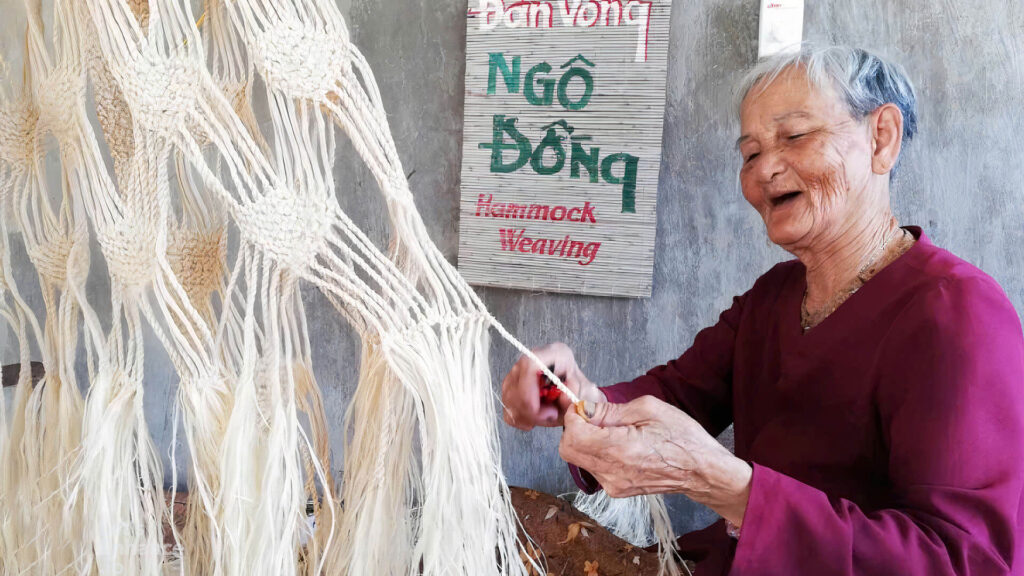Ngô Đồng tree-bark hammock weaving in Cu Lao Cham, Tam Hiep Commune, Da Nang City, was inscribed on the List of National Intangible Cultural Heritage in 2024.
In the course of living and adapting to the island environment, the inhabitants of Cu Lao Cham accumulated a wealth of experience and folk knowledge in their daily lives. More than 100 years ago, when industrial household products were not yet common—especially for Cu Lao Cham, an island far from the mainland—the people here had to be self-sufficient in many aspects. With their diligence, resilience, and skillful hands, they knew how to make use of available materials to create many valuable handicrafts, rich in artistic character, to serve everyday life.

From an early time, the local inhabitants discovered that fibers extracted from the bark of the red Ngô Đồng tree, which grows abundantly on Cu Lao Cham Island, possessed qualities of toughness, durability, softness, silk-like sheen, and high tensile strength. As a result, these fibers were used to craft traditional handwoven and braided items for household use.
The people learned to process the bark of the Ngô Đồng tree into fibers for tying and binding household items, as well as for securing bird’s nests for export. Notably, the fibers were also used to weave hammocks that proved highly durable and widely favored, leading to the popularity of Ngô Đồng tree-bark hammocks in the local community.
The majority of women living in Cu Lao Cham know how to weave Ngô Đồng tree-bark hammocks. Young girls were taught the craft early by their mothers and grandmothers, and they would take advantage of their spare time to weave hammocks. At that time, the people of Cu Lao Cham wove hammocks solely for household use.
HISTORY OF THE FORMATION AND DEVELOPMENT OF THE CRAFT
According to the village elders, Ngô Đồng tree-bark hammock weaving is a traditional handicraft of the island community, and from their grandparents’ time, people already knew how to use the bark of the Ngô Đồng tree to weave hammocks. However, up to now, there has been no documentation determining the exact time of the formation and development of Ngô Đồng tree-bark hammock weaving in Cu Lao Cham. In The Complete Works of Nguyen Tuan (written between 1940 and 1945), the writer Nguyen Tuan even used “Ngô Đồng Hammock” as the title of one of his essays.
Later on, this product was purchased and used by people from other localities, especially fishermen from the mainland going out to sea. Over time, as demand for the product increased, the local inhabitants had the opportunity to further develop the craft of Ngô Đồng tree-bark hammock weaving.
Throughout its existence and development, this traditional craft at times seemed on the verge of fading away due to the emergence and growing popularity of industrial-fiber hammocks on the market. Nevertheless, in order to preserve the knowledge, techniques, and indigenous skills associated with this traditional practice, the local people have endeavored over generations to maintain and pass down the distinctive hammock-weaving craft of the island to their descendants.
In particular, since its recognition by UNESCO as a World Biosphere Reserve in 2009, tourism in Cu Lao Cham has begun to flourish. Ngô Đồng tree-bark hammock weaving has since become more widely known among both domestic and international visitors and has been recognized for the uniqueness of its products.

Ngô Đồng Tree Road in Cu Lao Cham – Photo: Pham Thi Ngoc Hoa
MATERIALS AND CHARACTERISTICS OF THE PRODUCT
The Ngô Đồng tree-bark hammock is one of the distinctive products of Cu Lao Cham, made from the red Ngô Đồng tree (Firmiana colorata R. Br), also known locally as bo rừng or trôm màu — a woody plant with dark green leaves and bright red summer blossoms, growing abundantly on the steep cliffs of the island.
The Ngô Đồng tree-bark hammock is woven from extremely sturdy Ngô Đồng fibers and features multiple mesh knots. Depending on its size, the hammock is classified into three types: the three-strand hammock, the four-strand hammock, and the six-strand hammock. The three-strand hammock consists of three fibers (tao) at each mesh knot, the four-strand hammock has four fibers, and the six-strand hammock has six fibers.
The Ngô Đồng tree-bark hammock is highly durable, and with proper care, its lifespan can range from 15 to 20 years.
A special feature of lying in a Ngô Đồng tree-bark hammock is that, being made entirely from natural fibers, it massages the body’s acupuncture points and absorbs perspiration, making it especially beneficial for those suffering from leprosy, rheumatism, and similar ailments.
Unlike nylon hammocks, the Ngô Đồng tree-bark hammock is cool in summer and warm in winter. These qualities contribute to the distinctive value of the Ngô Đồng hammock in Cu Lao Cham, Hoi An.
CRAFTING PROCESS
Creating a hammock involves many intricate stages, carried out entirely by hand. First, the weaver selects a straight Ngô Đồng tree with a trunk about the size of a wrist or slightly smaller. After cutting, the bark is pounded and soaked in spring water to soften the hard outer layer. The whitish fiber inside (locally called manh đồng) is then extracted, washed clean, and sun-dried for about a day.
When the fibers dry and turn bright white with a silky sheen, they are ready to be stripped, spun into threads, and woven into hammocks. Completing a single hammock requires between 1.5 to 2 months of work.
Ngô Đồng tree-bark hammock weaving is an arduous craft, requiring the artisan to be patient, meticulous, skillful, and technically adept in every stage of the process. The procedure for weaving a hammock begins with stripping the manh đồng fibers, shaping the hammock’s head, creating the loops (con chàng), forming the base, weaving the body of the hammock, making the edges, and finally finishing the hammock.
While weaving, as the end of a Ngô Đồng fiber gradually thins out, the artisan must simultaneously braid and splice in a new fiber. With meticulous, skillful hands and the experience and knowledge accumulated through years of practice, the hammock weavers of Cu Lao Cham have developed an exquisitely refined technique of splicing Ngô Đồng fibers so smoothly that the joints are nearly invisible. After splicing, the fiber is tightly twisted to ensure that the joint does not show, thereby guaranteeing both aesthetic appeal and durability, while preventing slippage.
Thus, throughout the weaving process, whenever a Ngô Đồng fiber runs out, the artisan splices in another, yet not a single joint ever comes loose. The fibers remain smooth and elegant. While braiding, the weaver must constantly maintain tension so that the Ngô Đồng fibers stay firm, straight, and untwisted. Only in this way will the finished hammock avoid sagging, achieve the desired softness, and ensure uniformity, strength, and tightness.
Each Ngô Đồng fiber is simultaneously woven and twisted by the hands of the local women, tightened firmly to create a hammock adorned with harmoniously arranged and delicate patterns. The fibers thus become soft, providing a sense of comfort and ease for the user.
ARTISANS AND THE STATE OF PRESERVATION
At present, the number of people skilled in Ngô Đồng tree-bark hammock weaving within the community of Tan Hiep Island Commune is limited, consisting mainly of elderly individuals. Currently, there are seven practitioners in the commune, concentrated in Bai Lang and Bai Ong hamlets. The average age is relatively high, over 50 years old, with four individuals over 85. Among them, the most experienced artisan has practiced the craft for 54 years, while the least experienced has practiced for 7 to 8 years.
For centuries, the craft of Ngô Đồng tree-bark hammock weaving has continued to exist and develop in the island region of Cu Lao Cham.
The Ngô Đồng tree-bark hammock carries not only material value but is also closely tied to the formation and development of the land, embodying the sentiments and affections of the island’s inhabitants. This traditional handicraft involves many stages and complex techniques, yet retains a deeply folkloric and artisanal character, producing a distinctive local handicraft. The craft not only contributes to the livelihood of its practitioners but also helps create a unique tourism product associated with the maritime culture of Cu Lao Cham.
The Ngô Đồng tree-bark hammock weaving products of the Cu Lao Cham community represent a form of folk culture, rich in information. Through these products, we can gain some understanding of the lifestyle of the local inhabitants. This demonstrates that, since ancient times, the people of Cu Lao Cham have known how to utilize the natural resources of the forest to meet their daily needs on the island.
Therefore, Ngô Đồng tree-bark hammock weaving serves as evidence of the community’s early access to and utilization of forest resources, demonstrating their adaptation to the island’s maritime terrain.
From the distinctive values of Ngô Đồng tree-bark hammock weaving, tied to the long-standing historical and cultural traditions of generations of residents in Cu Lao Cham, this traditional handicraft in Cu Lao Cham, Hoi An, was inscribed on the List of National Intangible Cultural Heritage under Decision No. 381/QĐ-BVHTTDL, dated February 21, 2024, by the Ministry of Culture, Sports and Tourism.
This is an honor for the people of Hoi An, Quang Nam (now Da Nang), and at the same time, it serves as one of the foundations for preserving, safeguarding, and promoting this traditional handicraft closely associated with the maritime culture of Cu Lao Cham, Hoi An.
DA NANG CITY TOURISM PROMOTION CENTER